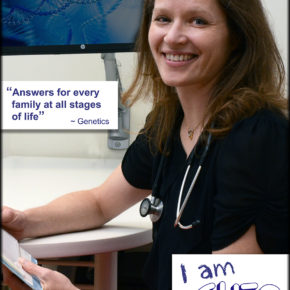Dr. Sarah Sawyer is a Clinical Geneticist in the Department of Genetics and Associate Professor of Pediatrics at the University of Ottawa. She completed her PhD in Genomics at the Karolinksa Institute in Stockholm, Sweden and then pursued her MD at the University of Calgary where she also completed her residency training in Medical Genetics and Genomics, followed by a one year clinical and research fellowship in Translational genomics and genomic sequencing with Dr. Kym Boycott. Her sub-specialty is in patients with rare disease and inherited pediatric cancer syndromes. Her research program is in using genomics sequencing technologies to improve diagnostic rates for these patients and to understand the underlying biology of these diseases to ultimately identify therapeutic targets to improve the management and outcomes for patients.
Research Projects
-
Histone H3K36 mutations promote sarcomagenesis through altered histone methylation landscape
30/06/2016
We present evidence that the H3K36M mutation plays a driver role in the development of mesenchymal neoplasms through impaired differentiation of MPCs. Although H3.1 and H3.3 K36M are found at different genomic locations, they result in the same genome-wide changes in chromatin landscape, gene expression profile, and tumorigenic capacity. These data imply that the specific genomic locations of H3K36M-containing nucleosomes are relatively unimportant for K36M's function. While other non-mutually exclusive mechanisms may be involved (19), the dominant inhibition of H3K36 methyltransferases is a critical downstream event mediating H3K36M's differentiation-arresting potential. The concurrent inactivation of multiple methyltransferases via a single missense mutation in histone H3 provides an efficient means to "lock" cells into an aberrant chromatin state that, in the context of mesenchymal progenitors, promotes neoplastic transformation. Our study highlights an underappreciated role of intergenic H3K36 methylation in polycomb complex recruitment through the antagonization of H3K27me3 propagation (20, 21) and demonstrate that modest alterations to the intergenic to gene-associated H3K27me3 ratio can have profound outcomes on polycomb-mediated gene silencing. We speculate that similar mechanisms may underlie other human cancers where histone H3K27 and K36-directed enzymes are frequently dysregulated.
-
Utility of whole‐exome sequencing for those near the end of the diagnostic odyssey: time to address gaps in care
01/03/2016
In the next decade we will witness a paradigm shift in the way we care for patients with rare genetic diseases, addressing a significant gap in the management of individuals with rare diseases. The diagnostic journey for patients will include clinical genomic sequencing, which in the not too distant future will be WGS as costs decrease with new platforms. The accessibility of WGS‐based diagnostics for patients will be central to understanding the complete compendium of human genetic pathology. Strategies and infrastructure should be put in place to facilitate discovery in clinical settings, and to further mine large phenotypic and genomic datasets for disease mechanisms. As we understand the etiology of more rare diseases, it is probable that we will increasingly implicate known genes and that the approach to the completion of the complete Mendelian dataset will be asymptotic. There will be a subset of rare diseases that are due to non‐coding mutations in regulatory regions that may be more readily identified with the imminent use of WGS and RNA sequencing, and to implicate and understand this type of variation will require large‐scale data sharing at an impressive level. Ultimately, such datasets will be instrumental in identifying modifiers of disease, providing insight into phenotypic variability, prognosis, and for a subset of diseases, identifying drug targets. Finally, NGS technologies are providing significant opportunities to implement personalized health strategies including prevention or early detection of disease, improved health maintenance, and development of tailored therapy for patients with rare genetic diseases.
-
Biallelic Mutations in BRCA1 Cause a New Fanconi Anemia Subtype
01/08/2015
The proband presented at birth with microsomia and dysmorphic features (Fig. 1A). Growth parameters were less than the 0.4 percentile at term (birth weight 1990g, height 40.5 cm, head circumference (HC) 27 cm), and subsequent catch-up growth was not evident at 25 years of age (weight 40 kg, −3.03 S.D.; 135 cm tall, −4.35 S.D.; HC 48.5 cm, approx.−4 to −5 S.D.). Additional congenital abnormalities included sparse hair, upslanted palpebral fissures, blepharophimosis, a narrow palate, dental malocclusion, a high-pitched and hoarse voice, hyper and hypopigmented skin lesions, duodenal stenosis and a slightly enlarged left kidney. She has proximally inserted thumbs (Fig. 1A), 2nd digit camptodactyly, 2–3 toe syndactyly and hyperextensible knees as well as a history of hip dislocation. Conductive hearing loss was diagnosed at 4 years of age. Bone age at 2y 3m was delayed (1y and 6m (−2S.D.)), but had normalized by 9 years. The patient also has mild intellectual disability with significantly delayed speech. At 23 years of age she was diagnosed with ductal breast carcinoma that was estrogen and progesterone receptor positive and Her2 negative. Mastectomy was performed followed by treatment with docetaxel, fluorouracil-epirubicin-cyclophosphamide and radiation therapy. A prophylactic mastectomy was performed on the contralateral breast at age 25. The patient did not experience unusual treatment associated toxicity and has not been diagnosed with bone marrow failure to date.

